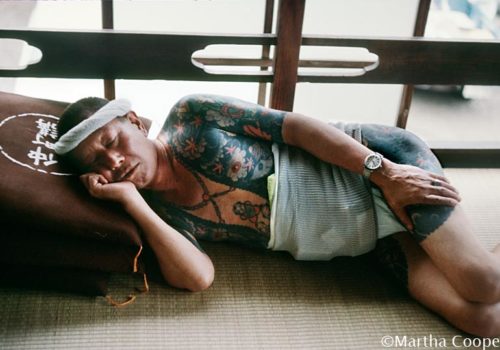In 1970, photographer Martha Cooper spotted a man in a crowd. On his back was a Japanese tattoo, figures drawn in the style of a woodblock print. Entranced by this vision, Cooper followed him until he disappeared, and soon thereafter began questioning her friends about the subject. It was a touchy topic—it had been outlawed in 1872 and legalized again in 1948 and as the decades intervened, tattoos became symbols of the yakuza, the gangsters and the underworld of Japan. This is because the images of tattoos were seen in films, and is all too common, what is constructed for entertainment is taken as truth.
Fortunately, Cooper delved deeper, and discovered an ancient art, the art of the ornamental flesh that has traditionally defined members of the working class. As Cooper explains, “Tattooing properly is a difficult skill and therefore to get tattooed has always been expensive. A bad tattoo artist could kill you by pricking your skin to deeply with poisonous inks. A laborer who as a full upper body tattoo has to earn a lot of money to pay for it. Thus the most beautiful and extensive tattoos are symbols of wealth and prestige.” And it was with this basis for understanding that Cooper visited tattoo master Horibun I in Tokyo and documented his world.
Tattoo Tokyo 1970 (Dokument Press) is a beautifully produced volume of this work. Tall, slim, and elegant, the book is as much an objet d’art as the work itself. This volume features two brief essays by Cooper describing her study, the writing as rare as the images themselves for Cooper usually allows her photographs to speak for her. Cooper’s essays add insight and context to the work, providing us with a stage and a setting for the scenes about to unfold.
As Cooper describes, “In the corner of the room say a young girl of about 18, who I assumed was Mr. Horibun’s daughter or assistant. She greeted me and we chatted, avoiding the subject of tattooing. Mrs. Horibun brought us tea and as we were sipping it, began making preparations. She moved aside the little table, rolled out a narrow mat and adjusted the overhead light. Mr. Horibun then walked into the room without ceremony and began to prepare the inks. To my surprise, I saw that the inks were nothing more than the usual ones used for calligraphy. As Mr. Horibun rubbed the ink stick in water on a stone, the young girl who had been sitting demurely beside me began to unbutton her blouse. I realized for the first time that she was the one to be tattooed but did my best to hide my amazement.”
And it is this young girl who receives a striking piece outlined upon her back, a girl kneeling while contemplating a branch in her hands. Cooper carefully documents the work of Horibun I, and we see how the master uses flesh as canvas for a drawing that has as many layers of work as it does symbolic importance. In Cooper’s photographs we also see the human as canvas themselves, and can consider the dialectic between ideas which are usually quite distinct. Through the process of creation artist and the artwork are forever fused with the owner themselves—for the act of wearing a tattoo is as much about adornment as it is about expressing the inner self.
This particular form of art is unlike any other, for it is permanent in the most temporal state, and just as the body does, it ages and changes over time. Tattoos last as long as life, and after this moment all that remains are the images themselves. The individually decorated body telling a story that is all their own, the style of design as distinctive as the face that wears it proudly. Cooper’s work for Tattoo Tokyo 1970 is a stunning document of a place and a time that brings together history and ritual, tradition and spectacle, expression and artifact in an eloquent volume.
















